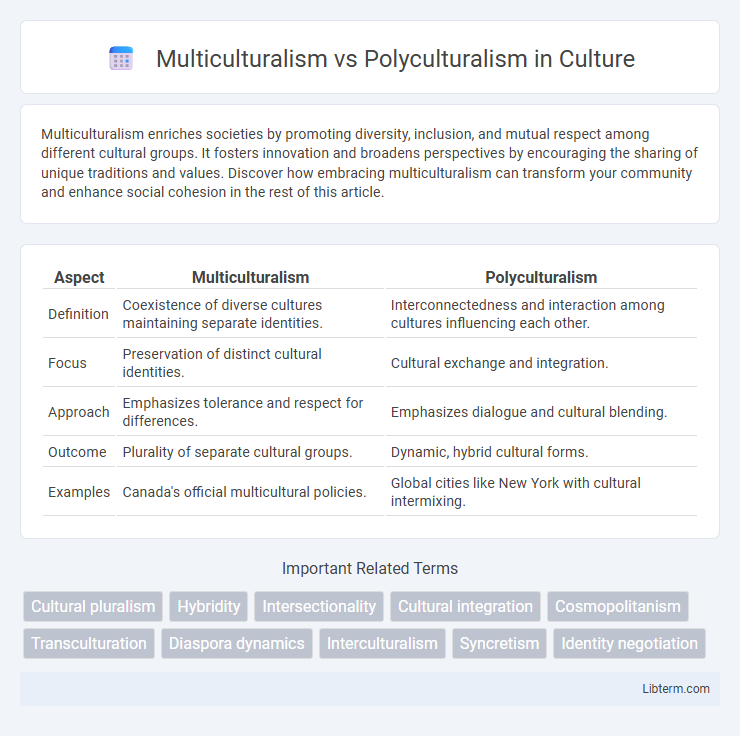Multiculturalism enriches societies by promoting diversity, inclusion, and mutual respect among different cultural groups. It fosters innovation and broadens perspectives by encouraging the sharing of unique traditions and values. Discover how embracing multiculturalism can transform your community and enhance social cohesion in the rest of this article.
Table of Comparison
| Aspect | Multiculturalism | Polyculturalism |
|---|---|---|
| Definition | Coexistence of diverse cultures maintaining separate identities. | Interconnectedness and interaction among cultures influencing each other. |
| Focus | Preservation of distinct cultural identities. | Cultural exchange and integration. |
| Approach | Emphasizes tolerance and respect for differences. | Emphasizes dialogue and cultural blending. |
| Outcome | Plurality of separate cultural groups. | Dynamic, hybrid cultural forms. |
| Examples | Canada's official multicultural policies. | Global cities like New York with cultural intermixing. |
Understanding Multiculturalism: Definition and Principles
Multiculturalism emphasizes the coexistence of diverse cultural groups within a society, promoting equal respect and recognition for each culture's unique identity and practices. It upholds principles of cultural pluralism, social inclusion, and mutual tolerance, aiming to protect minority rights and prevent cultural assimilation. This framework encourages institutional support for cultural diversity through policy initiatives and education that celebrate distinct traditions while fostering social cohesion.
What Is Polyculturalism? Key Concepts Explained
Polyculturalism emphasizes the interconnectedness and dynamic interactions between diverse cultural groups, highlighting shared histories and mutual influences rather than treating cultures as isolated and static entities. Key concepts include cultural hybridity, fluid identities, and the acknowledgment of ongoing cultural exchange, which contrast with multiculturalism's focus on coexistence of distinct cultures within a society. This approach fosters deeper integration and understanding, promoting collaboration and innovation through cultural blending and collective growth.
Historical Roots of Multiculturalism
The historical roots of multiculturalism trace back to post-World War II immigration policies and decolonization, which prompted societies to recognize and accommodate diverse ethnic and cultural groups within liberal democracies. Multiculturalism emerged as a response to cultural pluralism and minority rights movements, emphasizing the protection and celebration of distinct cultural identities. This framework contrasts with polyculturalism, which highlights the dynamic interactions and blending of cultures rather than mere coexistence.
The Evolution of Polycultural Thought
Polycultural thought has evolved to emphasize the interconnectedness and dynamic interactions among cultures, contrasting with multiculturalism's focus on preserving distinct cultural boundaries. This evolution highlights how cultural identities continuously shape and influence one another, fostering collaboration and hybridization in social practices. Scholars increasingly argue that recognizing relational cultural exchanges promotes more inclusive and adaptive societal frameworks than static multicultural paradigms.
Core Differences: Multiculturalism vs Polyculturalism
Multiculturalism emphasizes the coexistence of distinct cultural groups maintaining their unique identities within a shared society, often focusing on equality and inclusion of diverse traditions. Polyculturalism highlights the interconnectedness and dynamic interactions among cultures, promoting exchange and hybridity rather than separation. The core difference lies in multiculturalism valuing boundary maintenance, whereas polyculturalism encourages cultural blending and mutual influence.
Impact on Social Integration and Community Cohesion
Multiculturalism emphasizes maintaining distinct cultural identities within a pluralistic society, often leading to parallel communities that may hinder full social integration and limit cross-cultural interaction. Polyculturalism promotes interconnectedness and the blending of cultures, fostering dynamic exchanges that enhance community cohesion and support more inclusive social bonds. Studies indicate polycultural approaches encourage mutual understanding and collective identities, which are crucial for reducing social fragmentation and promoting cohesive societies.
Policy Approaches: Multicultural vs Polycultural Frameworks
Multicultural policy frameworks emphasize recognizing and preserving distinct cultural identities within a society, promoting diversity through separate cultural rights and representation. Polyculturalism policies focus on the dynamic interactions, exchanges, and blending among cultural groups, encouraging integration and hybridity rather than maintaining fixed cultural boundaries. Governments adopting multicultural approaches implement measures such as language rights and cultural celebrations, while polycultural policies foster intercultural dialogue and collaborative community practices to enhance social cohesion.
Cultural Identity: Preservation, Blending, and Transformation
Multiculturalism emphasizes the preservation of distinct cultural identities within a shared society, fostering coexistence without significant blending. Polyculturalism promotes the dynamic interaction and blending of cultures, leading to transformative cultural identities shaped through continual exchange. Both approaches influence how individuals and communities negotiate cultural boundaries and evolve their sense of identity amidst diversity.
Criticisms and Controversies of Each Approach
Multiculturalism faces criticism for promoting cultural segregation, which can hinder social cohesion and lead to superficial celebrations of diversity without addressing systemic inequalities. Polyculturalism is often challenged for oversimplifying complex cultural identities and risking cultural appropriation by emphasizing interconnections that may not exist uniformly across communities. Both approaches encounter controversies regarding their effectiveness in fostering genuine inclusivity while balancing respect for distinct traditions and the need for social integration.
Towards Inclusive Societies: Future Directions and Challenges
Multiculturalism emphasizes coexistence of diverse cultural groups within a society, often highlighting distinct cultural boundaries, while polyculturalism promotes interconnectedness and dynamic interactions among cultures, fostering hybrid identities and collaborative social frameworks. Future directions for inclusive societies involve integrating polycultural approaches to enhance social cohesion, reduce cultural segregation, and promote mutual respect in increasingly globalized contexts. Challenges include addressing systemic inequalities, combating cultural essentialism, and developing policies that support both cultural distinctiveness and intercultural exchange to build resilient and equitable communities.
Multiculturalism Infographic

 libterm.com
libterm.com